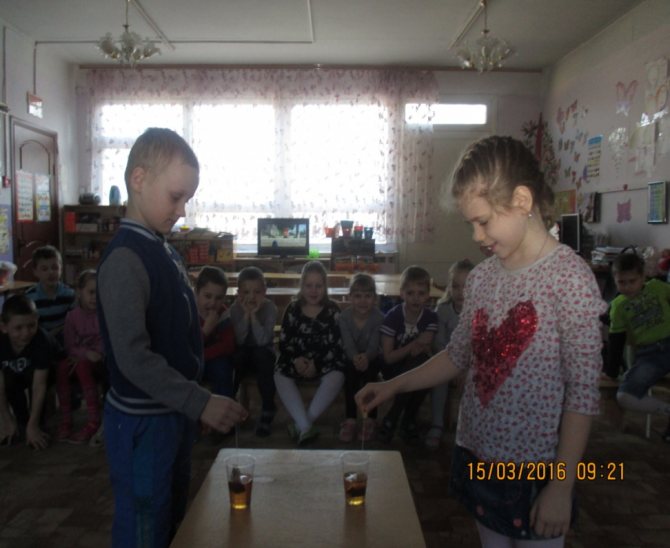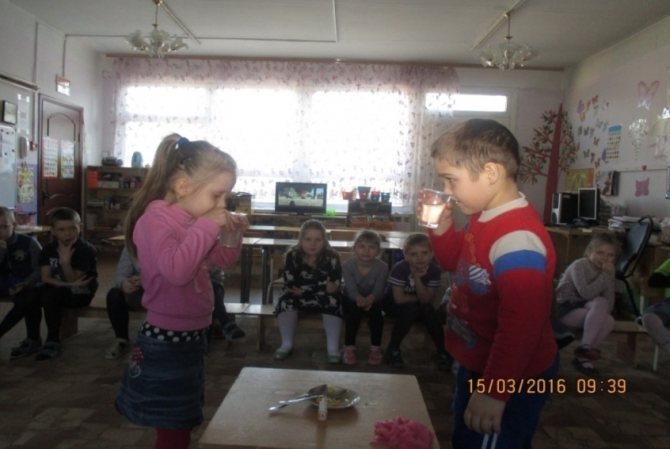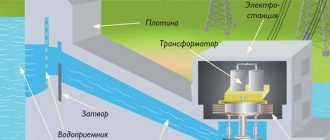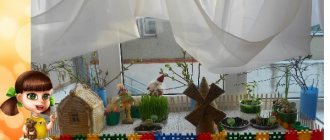Experimental - research project for the preparatory group “Magical properties of water”
Experimental - research project “Magical properties of water”
Water is a life-giving force
The first substance that a baby gets acquainted with is water. It gives the child pleasant sensations, develops various receptors and provides almost unlimited opportunities to explore the world and himself in it.
Water is a life-giving force, a miracle of nature and the wealth of the planet. She is the source of life.
Water plays a huge role in our lives; it is our constant companion.
Objective of the project:
To develop preschoolers’ cognitive interest in water as an object of inanimate nature.
Project objectives:
- To develop in children knowledge about the importance of water for all life on earth;
- Develop ideas about the properties and conditions of water;
- Develop basic experimentation skills
- Foster respect for water.
- Organize an exhibition of children's works "Who needs water"
Expected Results
- As a result of the implementation of this project, students will develop a careful and economical attitude towards water resources.
- Learn simple ways to experiment with water
- Children will develop age-appropriate research skills (they will ask questions of a natural history nature, establish cause-and-effect relationships, and there will be a need to obtain experimentally).
- The educational competence of parents in environmental education of preschool children will increase.
Stage
I. Preparatory Tasks:
- Identify children’s existing knowledge about water and the level of children’s interest in this topic.
2. Enrich the subject-ecological environment in the group to implement the project “The Magical Properties of Water.”
Forms of work
Selection of equipment for experimental activities, development of a card index of games with water, finger games of a natural history nature, selection of children's literary works, videos, cartoons, illustrations about inanimate nature.
Design of didactic games, selection of literature
II
.
Main Objectives:
- Clarify and expand your understanding of the properties of water.
- To consolidate the importance of water in our life, to show in what form it exists, the variety of states of water.
- Develop curiosity, cognitive activity, and interest in experimentation.
- Foster a consciously correct attitude towards natural resources.
Experimental activity.
Experiment 1. “Can water be colored?”
For this experiment, children were given a glass of water and tea bags. Each child put a tea bag into a glass, the water took on the color of tea.
As a result of this experiment, the children concluded that water can be colored with various coloring substances.

Experiment 2. “Does water have a shape?”
During this experiment, children were offered different sizes and shapes. They poured water into these molds.
As a result of this experiment, the children concluded that water has no shape, but if it is poured into any container, it takes on the shape into which the water was poured.
Experiment 3. “Does water have taste?”
At the beginning of this experiment, they were asked to taste the water. After that they added sugar, salt, lemon juice.
As a result of this experiment, the children concluded that water has no taste, but if you add salt, sugar or lemon juice to it, the water acquires exactly their taste.
Experiment 4. “Can water dissolve substances?”
The children were given the task of dissolving salt, sugar, lemon juice, vegetable oil, nails, and sand in water. Each child threw their own ingredients into the water. Only sugar, salt and lemon juice dissolved in water.
As a result of this experiment, the children concluded that water is a solvent, but not all substances dissolve in it. For example: sand, vegetable oil, nail.
Experiment 5. “Does water have a smell?”
The children were asked to identify the smell of the water. After they said the water was odorless, vanilla and orange flavors were added to the water.
As a result of this experiment, the children concluded that the water has no odor, but when vanilla extract and lemon juice were added, the water acquired their aroma.

Experiment 6. “Does temperature affect the state of water?”
At the beginning of this experiment, the children poured water into molds and placed them on the balcony overnight. In the morning, when they came to the kindergarten and took the forms from the balcony, the children saw that the water had frozen and turned into ice. Then these pieces of ice remained in the group, and in the evening the children noticed that the water had melted and became liquid.
As a result of this experiment, the children concluded that in cold air, water freezes and turns into ice, and in warm air, ice melts and turns back into water.
As a result of these experiments, the children concluded that water:
Water is a liquid; has no shape, color, taste; it's transparent.
— Other substances can dissolve in water, then it changes taste and color.
— Water has a temperature, depending on it, water changes its properties.
—Water takes on the form into which it is poured.
— Water acquires the taste of the substance that was added to it.
Experiment “How to purify water?”
During this experiment, children passed water through a paper napkin, a paper napkin and sand, a bandage and cotton wool, and an aqua filter.
During the study, they came to the conclusion that if “dirty” water is passed through a napkin, sand and coal, then the water can be purified, but the purest water is that passed through an aquafilter.
Conversation “Clean Water”
- From the conversation, the children learned that spring water and water from deep wells are considered clean because it has been filtered through many layers of the earth.
- We also talked about the fact that there are large industrial filters for water purification at water intakes, so that clean water flows into our homes.
- And if rusty water flows in our taps, it means that the pipes through which it flows are already old and require replacement.
Exhibition of children's works "Who needs water?"
III
.
Final Objectives:
- Draw conclusions about the properties of water and what methods can be used to purify it.
- Fostering an environmental culture in children.
Conclusion
- A careful and economical attitude towards water resources has been formed.
- Children mastered simple ways to experiment with water
- Children developed age-appropriate research skills (children began to ask natural history questions and establish cause-and-effect relationships.
MAGAZINE Preschooler.RF
Short-term project “Water Sorceress” for the senior group of preschool educational institutionsProject participants: teacher and senior children.
Project duration: week
Relevance:
Scientific and practical progress is constantly expanding the use of natural resources, and also contributes to the involvement of ever larger territories in human economic activity. The result of this process is the increasing destruction of natural ecological systems. In this regard, issues of caring for nature, preserving its pristine beauty, and improving the protection of biodiversity require urgent solutions
Preschool childhood is the first stage where knowledge about the world around us is intensively accumulated and a multifaceted attitude towards people and nature is formed. The components of the ecological culture of a preschooler’s personality are knowledge about nature and its environmental orientation, the ability to use it in real life, in behavior, in various activities.
Object: Water in our lives.
Hypothesis: We assumed that it is impossible to live without water
Problem: Children lack ideas about the importance of water in human life, about the properties and qualities of water and a careful attitude towards it.
Justification of the problem:
Insufficient knowledge on the physical properties of water, as well as its significance;
Deterioration of the environmental situation
Project goal: To generalize and expand the cognitive interest of preschool children in water as an object of inanimate nature.
Tasks:
- Develop ideas about the properties (taste, color, smell, fluidity) and states of water (solid, liquid, gaseous);
- To develop in children knowledge about the importance of water for all life on earth;
- Develop basic experimentation skills;
- To form a conscious, careful attitude towards water as an important natural resource;
- Development of creative abilities of adults and children in the process of joint activities;
- Improve work on interaction with parents, intensify the position of parents as participants in the pedagogical process of the kindergarten;
- Create conditions for the development of children's cognitive interest, creative imagination and thinking, as well as communication skills.
Expected results:
- Expand and deepen the child’s knowledge and understanding of the world around him, including water.
- Master basic experimentation skills
- Gain experience in humane treatment of plants and living beings.
- Increased knowledge in the field of research skills (establish cause-and-effect relationships).
Project implementation principles:
The principle of differentiation and individualization presupposes the creation of conditions for the full manifestation of the abilities of each child and timely educational work.
The principle of conformity with nature indicates that the educational process corresponds to both internal nature and external conditions.
The principle of dialogic communication as an integral condition for the interaction of subjects, which reflects the close connection between mutual and reciprocal openness, sincerity, mutual understanding of the teacher and the child, and projects an attitude towards reasonable assimilation.
The principle of accessibility provides for the implementation of environmental work taking into account the characteristics of age, preparedness, as well as the individual characteristics and mental development of children.
Systematic principle. Achieving the goal is ensured by solving a set of health, educational and educational tasks with appropriate content, which allows us to obtain a predictable result.
The principle of consistency is to gradually increase requirements in the process of environmental activities.
Project implementation forms:
Ecological activities.
Observations and ecological excursions.
Educational reading.
Laboratory "Experiments" (experiments and experiments).
Outdoor, didactic, simulation games, environmental dramatizations.
Project implementation stages:
Stage I: preparatory
Project resource support:
- Corner of ecology and experimentation in a group
- Methodological tools selection and compilation (card files of didactic games, lesson notes, entertainment scripts, etc.).
- A selection of literature on the topic (encyclopedias, maps, diagrams, fairy tales, poems, puzzles, sayings, etc.).
- A selection of experiences and experiments “Experiments with water”
- Collection of illustrative material
Stage II: main
Direction of work Purpose Benefits and equipment
Block I – Social and communicative development
Conversation “Water, water - water all around” To give children an idea of the importance of water in our lives and the form in which water exists in the environment (states of water - liquid, gaseous, solid).
Develop children's curiosity, thinking and speech; introduce the following words into the children's active dictionary: liquid, colorless, tasteless, transparent.
Foster respect for water. Abstract
Conversation “How does water in the seas and oceans differ from river and lake water?” Give an idea of some types of natural reservoirs, rivers, seas, lakes. Clarify children's knowledge about the location of water in nature and everyday life. The concept that water in reservoirs has different temperatures; depending on the temperature of the water, different plants and animals live in reservoirs. Abstract
Conversation “Cleanliness is beauty” to instill in children the habit of washing themselves, washing their hands with soap before eating, when dirty, after using the toilet; consolidate the ability to use a comb and handkerchief; teach children to turn away when coughing and sneezing and to cover their mouth and nose with a handkerchief. Ensure that children consciously observe the rules of personal hygiene and understand their importance. Cultivate neatness and neatness. Teach the basics of an aesthetic attitude towards your appearance; make it clear to children that a person’s appearance plays an important role in life; continue to consolidate knowledge of cultural and hygienic rules.
Assemble the “Boat”
Development of motor dexterity of the index and thumb of the child’s dominant hand; developing the child’s ability to arrange a mosaic pattern in accordance with the pattern
Mosaic
Finger game “Water - water” , “Washing hands” , “river and fish” , “On the water” Introduce children to new finger gymnastics, teach them to play it, while developing speech and evoking an emotional response. —
Block II – Cognitive development
Riddles “About Water” Effectively exercise the mind, develop thinking abilities. Promote the active development of figurative speech, enrich the vocabulary by deepening and clarifying knowledge about the subject. Help to master the imagery of words, acquire knowledge about word formation, develop a poetic ear and poetic perception Pictures depicting answers
Experiment No. 1: “Properties of water” Introduce children to the properties of water (takes shape, has no smell, taste, color, surface tension, etc.). Several transparent vessels of different shapes, water, three glasses, salt, sugar, a spoon, an odorous solution, dye of different colors
Experiment No. 2 “Water of Life” Introduce children to the life-giving properties of water. Freshly cut branches of quickly blossoming trees, a vessel with water, the label “Water of Living”
Experiment No. 3 “Evaporation” Introduce children to the transformation of water from liquid to gaseous state and back to liquid. Burner, vessel with water, lid for the vessel.
Experiment No. 4 “Aggregative states of water” Prove that the state of water depends on air temperature and is in three states: liquid - water; hard – snow, ice; gaseous - steam. Saucer, snow
Experiment No. 5 “Purification of dirty water” . Reinforce knowledge about the process of water purification in different ways. Plastic tubes, plastic funnel, plastic lid, plastic cup, bag of pebbles, bag of marbles, paper filters, sponge, measuring cup; for a glass, bandage, cotton wool, a glass of dirty water, a plate, oilcloth, a measuring spoon.
Block III – Speech development
Poem by S. Pogorelsky “Spring Stream” , L. Lyushin “Droplet” , E. Moshkovskaya “Drop in the Sea” , G.K. Anderson “Thumbelina” , story by N.A. Ryzhov “How People Offended a River” , “The Story of One pond” , “Once upon a time there was a River” , A fairy tale about the water cycle in nature Nadezhda Boltacheva Formation of interest and need for reading (perception) of books Books
A set of cards with images of a puddle, drops, flowers, steam, mountains, etc.
"Give me a word"
Develop children's speech and motor skills of the speech apparatus Book
IV block – Artistic and aesthetic development
Drawing by dots “Sea inhabitants” Formation of elementary mathematical concepts Sheet of paper, colored pencils
Drawing life-giving moisture Activate thought processes Sheet of paper, colored pencils
Applique “Beautiful fish in an aquarium” Introduce the technique of applicative mosaic. Colored paper, glue
Origami “White Water Lily” Improve your skills in creating three-dimensional paper crafts White paper
Block V – Play activities
Cut-out pictures Develop mental activity, consolidate knowledge about different bodies of water, cultivate a caring attitude towards water Photos of different bodies of water, cut-out pictures of water bodies, flags
Animals of reservoirs To consolidate the idea of the inhabitants of reservoirs, their adaptability to their environment; develop mental activity A set of cards for inhabitants of reservoirs and land, a model of a reservoir
Where are the snowflakes? Reinforce knowledge about the different states of water. Develop memory, cognitive activity Cards depicting different states of water: waterfall, river, puddle, ice, snowfall, cloud, rain, steam, snowflake, etc.
Block VI - Physical development
Outdoor game: “We are droplets” Develop children’s imagination and activity in the game.
Outdoor game: “In the swamp” Teach children to copy the movements of the inhabitants living in the swamp.
Outdoor game “We are big whales” Teach to follow the rules in outdoor games, develop children’s activity in the process of physical activity.
Ball game “Air, earth, water” To consolidate children’s knowledge about natural objects. Develop auditory attention, thinking, intelligence Ball
Creating snow figures Reinforce techniques: rolling, creating a ball, as well as knowledge about the properties of snow; encourage decorative design of the created image; develop the aesthetic and artistic taste of children. Snow, shovels, buckets
Joint activities of parents and children
1. Making a model of individual parts of the aquarium (algae, stones, fish, etc.)
Goal: To develop visual and effective thinking, to stimulate the search for new ways to solve practical problems by making various models, mastering the technique and skills of three-dimensional modeling, acquiring skills in working with paper, cardboard and using various available materials; development of spatial thinking.
2. Finding the necessary materials and collecting the waterfall
Stage III: Final
During the implementation of the “Water Sorceress” , children developed a careful and economical attitude towards water resources. Children mastered simple ways to experiment with water. The children developed age-appropriate research skills (they began to ask natural history questions and establish cause-and-effect relationships). The educational competence of parents in environmental education of preschool children has increased.
Result:
- Enriched and systematized knowledge of children about water, its properties, meaning, etc. A steady interest in studying this topic has been formed
- Increasing the competence of educators on the presented topic
- Developed methodological and didactic support on this issue
- Participation of families of pupils in the educational process.
| Next > |



